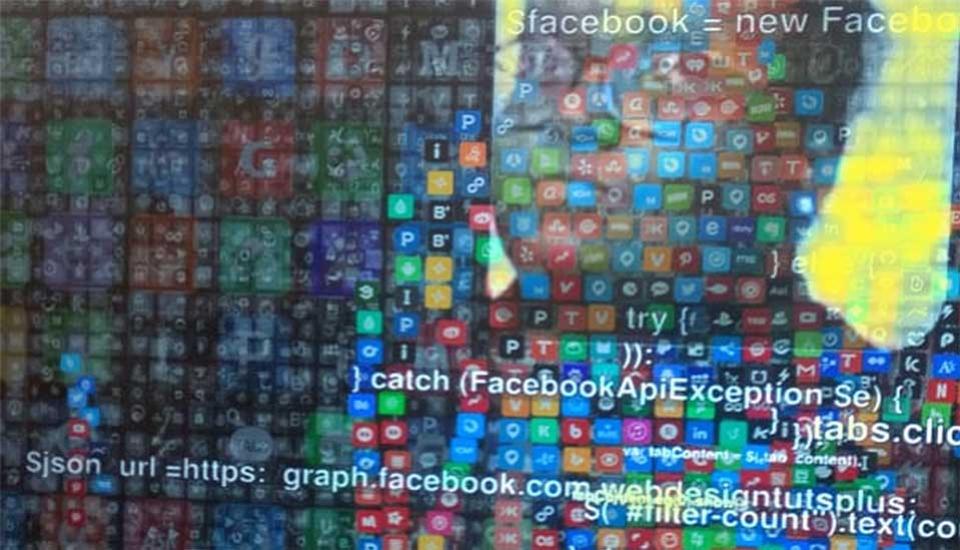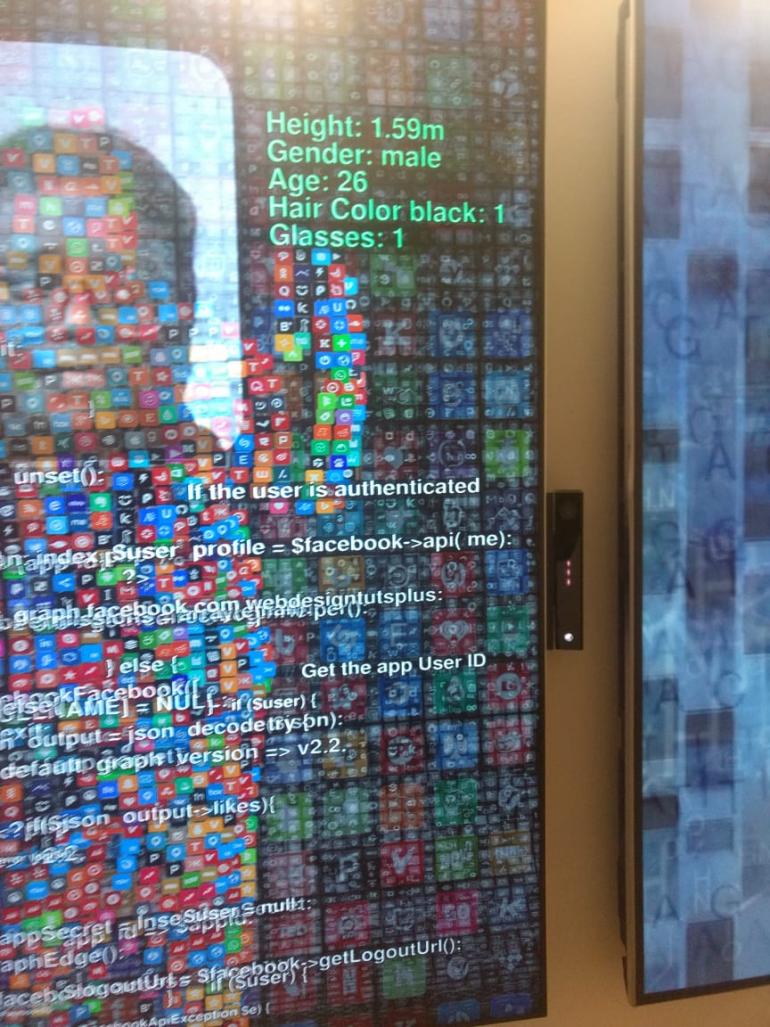
Image description: Visible outline of person against wall of apps. Image source: author.
In May earlier this year, the International Association of Athletics Federations (IAAF) said that it is mandatory for women athletes whose bodies produce high levels of testosterone to lower their levels to less that 5 nmol/L for six months before competing in track events from 400m to a mile. This was seen to have been done specifically to stop Mokgadi Caster Semenya from running the 800m races without taking medications to lower her testosterone levels. This rule has been temporarily suspended by the Swiss supreme federal court, permitting Caster to compete in the races at least till 25 June.
While this is temporarily good news, it’s important to think about what this says about policies and the space it affords to genders and sexualities which are not within the binaries. Even before Caster was subjected to a battery of tests by the IAAF, there was widespread media and public scrutiny of her because she was fast, and she was fast when appearing 'masculine', read as incorrectly woman. And all the more because Caster is a black lesbian woman.
Caster’s ongoing fight is a tangible example of how policies want boxes and a kind of static conformity. Anyone and anything that challenges this must be controlled, by force, by medication, or with more policy. The fact that Caster ‘appeared’ masculine once again broke the norms on what a woman should look like. And her ordeal began because of this lack of fitting into yet another box.
Caster’s ongoing fight is a tangible example of how policies want boxes and a kind of static conformity. Anyone and anything that challenges this must be controlled, by force, by medication, or with more policy.
Policies do not like things which don’t neatly fit into two boxes. They might even make their peace with it if there are more than two boxes, but the boxes are a must. There has been escalating calls and efforts by different governments to change the word ‘gender’ to ‘women’ in UN resolutions, and other attempts to restrict the purview of gender to the binary. These are often backed up by biologically deterministic ideas of gender based on genitalia. The unsaid offshoot of this is of course that these laws will only be used to protect those who not only fall within this binary, but also present and appear as per the norms of either side of the binary.
So what happens to intersex persons, trans persons, and non-binary or gender non-conforming persons in these policies and more? And what about in the spaces where these policy discussions and decisions take place?
During a meeting with a group of senators (Democrats) from the US, the senators told my colleague and me about how the NALSA judgement on the rights of transgender persons in India has also informed the law in their state around trans rights. As their state is one of those known for liberal LGBTQ laws, we enquired about the provisions within their law for the protection of the rights of non-binary or gender non-conforming persons. The senators’ reply basically was that there are already several issues that they are battling on the LGBTQ rights front, especially with increasing violence on black people and persons of colours, and that the idea of non-binary genders within their law is still far away as not many of them themselves even entirely understood it. This was not coming from a place of queerphobia or transphobia, but from a suspicion of these non-binary genders which are too fluid to be boxed. And if they cannot be boxed, then who are we giving rights to? Can there be any control exercised on these people? When this may be rooted in transphobia, it is a little different in that cis and trans are still binaries which they understood and stood by in the case of this state. (Of course, this comes with the expectation of trans persons to conform to the norms of their self-identified gender.) Our suggestion to the senators was to start by simply expanding the purview of the law against discrimination based on gender to encompasse all genders and not only women and trans persons.
But it’s never as simple as that.
So what happens to intersex persons, trans persons, and non-binary or gender non-conforming persons in these policies and more?
Bringing up gender in internet spaces
In the internet governance and tech related policy spaces, there is a very slow and steady increase in conversations around inclusion of gender (read women) in an attempt to bridge the digital gender gap. But does this conversation include trans persons, and gender non-conforming persons? What about trans persons who may still not have the freedom to express their chosen gender identity? Without bringing this into the conversation on bridging the digital gender gap, this will be an incomplete discussion which will translate into incomplete actions and implementation. An example of this from the internet governance and policy space is the Internet Governance Forum (IGF) where civil society, business and government come together, which takes place at the global, regional and national level.
There is a degree of concentrated effort to ensure that the intersection of gender and internet governance is addressed. This is done through the use of Gender Report Cards to determine the gender diversity among participants, speakers, and moderators as well as to see if the gender dimension was covered in the different sessions. But these report cards are not always completed, and they are not mandatory for all sessions. In fact, in the last year, there has been a sharp decline in the number of filled in Gender Report Cards which makes the data un-usable. When registering for the global IGF, there is an option to select ‘man’, ‘woman’, or ‘other’ under gender. The ‘other’ category without any space to specify this mysterious ‘other’ and self-identify is in itself problematic and tokenistic. When one submits a proposal for a session at the IGF, there are explicit questions included in the proposal form to determine if there is diversity at least on 3 counts from the following:
- Gender diversity
- Geography diversity
- Stakeholder group diversity
- Policy perspective diversity
- Accessibility diversity
- Youth diversity
- Local diversity
This is followed by a question to explain how one plans to remedy the criteria that one is not able to address at the time of proposal submission. When this is an interesting mechanism to ensure more diversity in the sessions, and avoid manels from the global north, I want to focus a little more on the Gender diversity. If we start the conversation from registering as a ‘man’, ‘woman’, or ‘other’ without any space for self-identifying, then the starting point in itself is problematic because you are starting at the binary with a vague third option. This is not helpful in pushing people to think of gender beyond women when thinking of speakers, moderators, and participants for their respective sessions.
One of the key roles of the IGF space is that it is a space where emerging issues on internet and technology are discussed. There is increasing discussion on big data, algorithmic decision-making, and the role of AI in judicial and other legal mechanisms, including that of facial recognition technology, biometric databases etc. These discussions are incomplete without looking at those who are most vulnerable to the use of these tech. OS Keyes, who wrote a paper titled The Misgendering Machines looking at the past 30 years of facial recognition research, specifically to understand why automatic gender recognition (AGR) is so widespread, found that researchers followed a binary model of gender more than 90% of the time. In research focused specifically on gender, more than 80% viewed it as a purely physiological construct. This leads to the erasure of trans persons and their needs, concerns and existence from both design as well as research, recreating the discrimination once again. The developers of facial recognition software are ignorant of non-static genders and presentations and the process of transitioning. And this will then translate into discriminatory actions.
The developers of facial recognition software are ignorant of non-static genders and presentations and the process of transitioning.
A 2015 research suggested that people could use facial recognition software in women’s bathrooms, and this will sound an alarm if men get too close, alerting an operator. This is just one instance. It’s not just about using only a binary model of gender but also this presumption that gender operates, presents and is determined in the same way across the world. A 2018 MIT study pointed out that AI running facial recognition software led to an increased number of false positives on any shade of skin that was not white as it was overwhelming trained with white faces.

Image description: Visible outline of person against wall of apps. Image source: author
Sexuality and sexual rights, including LGBTQ rights (with the possible exception of online gender based violence) in the digital spaces are still far and few.
Without bringing people of different sexualities, and gender identities and expressions to the table, policies and policy spaces and policy will be severely lagging behind the existing technology and the concerns arising from it. But it’s important to remember that bringing in trans persons and non-binary persons also means that one has to make the space accessible and safe for them. This includes providing funding to travel and attendance, orienting the staff at the space on different gender expressions, including explicit clauses against discrimination of trans and non-binary persons, having gender neutral bathrooms, making provisions for different gender identities in all the forms, and taking care of language in all literature among other things.
To have policies and laws and discussions around this without taking into account the fluid nature of gender and sexuality in the current times is extremely short-sighted. And not having diversity at the tables means that from the very beginning, things are not aligned properly and whatever follows will be non-inclusive and discriminatory. As Keyes says, “Values don’t just go into systems - they also come out of them.”
“Values don’t just go into systems - they also come out of them.”
- 4598 views







Add new comment